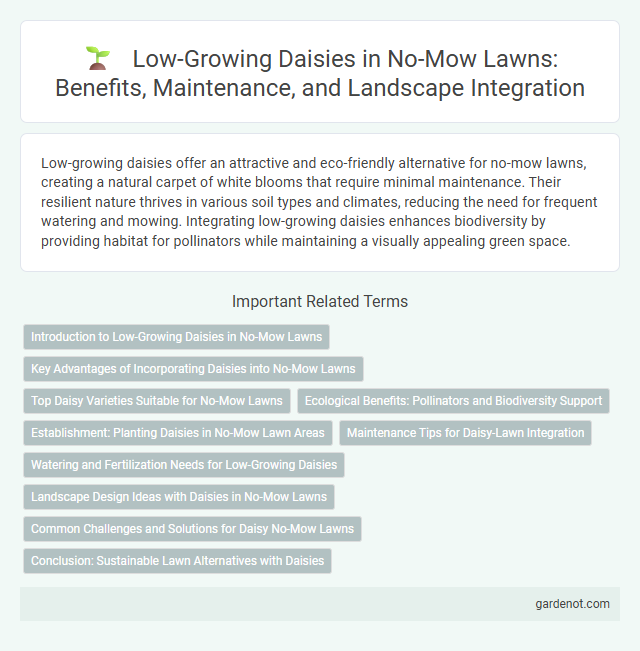Low-growing daisies offer an attractive and eco-friendly alternative for no-mow lawns, creating a natural carpet of white blooms that require minimal maintenance. Their resilient nature thrives in various soil types and climates, reducing the need for frequent watering and mowing. Integrating low-growing daisies enhances biodiversity by providing habitat for pollinators while maintaining a visually appealing green space.
Introduction to Low-Growing Daisies in No-Mow Lawns
Low-growing daisies thrive in no-mow lawns by providing vibrant, natural ground cover that requires minimal maintenance. These hardy perennials offer ecological benefits such as improved soil health and increased pollinator activity. Incorporating low-growing daisies enhances lawn biodiversity while maintaining a lush, weed-resistant landscape.
Key Advantages of Incorporating Daisies into No-Mow Lawns
Low-growing daisies enhance no-mow lawns by providing vibrant color and natural ground cover, reducing maintenance needs and water consumption. These hardy perennials attract pollinators like bees and butterflies, supporting local biodiversity and ecosystem health. Their deep root systems improve soil structure and prevent erosion, contributing to sustainable lawn management.
Top Daisy Varieties Suitable for No-Mow Lawns
Low-growing daisy varieties such as Bellis perennis and Erigeron karvinskianus are ideal for no-mow lawns due to their compact growth and minimal maintenance needs. These top daisy species provide vibrant blooms while tolerating infrequent mowing, enhancing lawn aesthetics with natural color and texture. Incorporating hardy daisies supports biodiversity and creates a sustainable, eco-friendly lawn solution.
Ecological Benefits: Pollinators and Biodiversity Support
Low-growing daisies in no-mow lawns provide essential nectar and pollen resources that attract and sustain a diversity of pollinators such as bees, butterflies, and hoverflies, enhancing local biodiversity. Their dense, ground-hugging growth reduces soil erosion and promotes habitat complexity, supporting beneficial insects and small wildlife. Integrating these daisies contributes to a resilient ecosystem, aiding in the preservation of pollinator populations and improving overall environmental health.
Establishment: Planting Daisies in No-Mow Lawn Areas
Low-growing daisies thrive in no-mow lawn areas due to their minimal height and spreading growth habit, which reduces the need for frequent mowing. Establishment involves selecting healthy daisy plugs or seeds, planting in well-drained soil, and ensuring consistent moisture during the initial growth phase. These daisies create an attractive, low-maintenance ground cover that supports pollinators and maintains ecological balance.
Maintenance Tips for Daisy-Lawn Integration
Low-growing daisies require minimal mowing, making them ideal for a low-maintenance no-mow lawn. Regularly remove weeds to prevent competition and promote healthy daisy growth, while watering moderately to maintain soil moisture without over-saturating. Periodic trimming of flower heads encourages denser foliage, enhancing the lawn's overall aesthetic and durability.
Watering and Fertilization Needs for Low-Growing Daisies
Low-growing daisies thrive with moderate watering, requiring soil to be kept consistently moist but not waterlogged, especially during dry spells. Fertilization is minimal, with a balanced, slow-release fertilizer applied once in early spring to promote healthy growth without encouraging excessive foliage. These daisies are adaptable to low-nutrient soils, making them ideal for no-mow lawns requiring low maintenance.
Landscape Design Ideas with Daisies in No-Mow Lawns
Low-growing daisies enhance no-mow lawns by providing vibrant white and yellow blooms that attract pollinators while requiring minimal maintenance. Incorporating these daisies into landscape design adds natural texture and seasonal color, creating visually appealing, eco-friendly green spaces. Their drought tolerance and slow growth make them ideal for sustainable lawns that reduce mowing frequency and promote biodiversity.
Common Challenges and Solutions for Daisy No-Mow Lawns
Low-growing daisy no-mow lawns often face challenges such as uneven growth, weed invasion, and susceptibility to foot traffic damage. Maintaining soil health through proper aeration and using organic mulch can improve growth uniformity and reduce weeds without mowing. Selecting hardy daisy varieties and limiting heavy foot traffic areas helps preserve the lawn's resilience and aesthetic appeal.
Conclusion: Sustainable Lawn Alternatives with Daisies
Low-growing daisies represent a sustainable lawn alternative by requiring minimal mowing and reducing water consumption compared to traditional grass. Their dense growth pattern naturally suppresses weeds and supports pollinators, enhancing biodiversity in residential landscapes. Integrating daisies into lawns promotes eco-friendly yard maintenance while maintaining aesthetic appeal and environmental benefits.
Low-growing daisy Infographic

 gardenot.com
gardenot.com